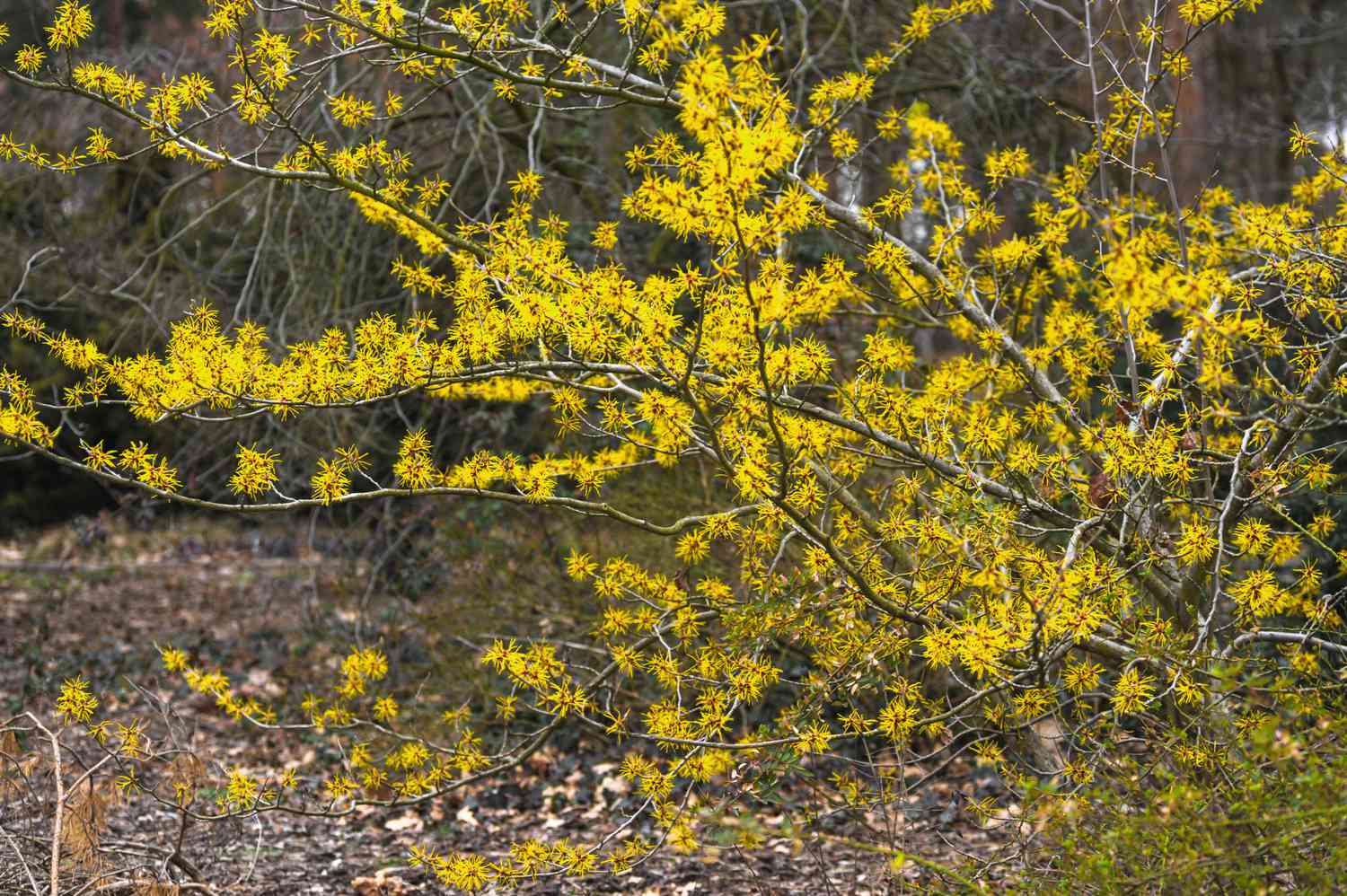
Hamamelis, commonly known as witch hazel, is a fascinating plant that has long captivated plant enthusiasts and herbal medicine practitioners alike. With its distinctive spidery flowers and healing properties, Hamamelis has a rich history and a range of uses that make it truly extraordinary.
In this article, we will explore 16 extraordinary facts about Hamamelis, shedding light on its origins, botanical characteristics, medicinal benefits, and much more. From its ancient roots in Native American rituals to its modern applications in skincare, this plant is truly deserving of our admiration and attention.
So, if you’re ready to delve into the captivating world of Hamamelis and discover its many wonders, let’s begin our journey together.
Key Takeaways:
- Hamamelis, also known as Witch Hazel, is an ancient plant with medicinal properties, beautiful flowers, and vibrant fall foliage. It’s a resilient and beloved addition to gardens and landscapes.
- Native American tribes valued Hamamelis for its spiritual significance and healing properties, using it in ceremonies and traditional medicine. Its unique seed dispersal mechanism ensures its survival and spread.
Hamamelis is an ancient plant.
Believed to have originated over 40 million years ago, Hamamelis, commonly known as Witch Hazel, is one of the oldest known plant species on Earth.
Hamamelis can be found in North America and Asia.
This fascinating plant genus is distributed primarily in eastern North America and eastern Asia, with a few species also found in parts of Europe.
Hamamelis is known for its unique flowers.
The flowers of Hamamelis are extraordinary in appearance, with their delicate, spidery petals that unfurl in the late winter or early spring, providing a burst of color during the colder months.
Hamamelis has medicinal properties.
For centuries, Hamamelis has been used for its medicinal properties. Its leaves, bark, and twigs are brewed into a soothing extract that is known for its anti-inflammatory and astringent effects.
Hamamelis is drought-tolerant.
One of the remarkable characteristics of Hamamelis is its ability to thrive in dry conditions. It has adapted to survive periods of drought, making it a resilient and hardy plant.
Hamamelis is a popular ingredient in skincare products.
Due to its natural astringent properties, Hamamelis is frequently used in skincare products like toners and facial cleansers. It helps to tighten pores and reduce inflammation, making it a sought-after ingredient in the beauty industry.
Hamamelis leaves and bark have been used by Native American tribes.
Native American tribes have long recognized the healing properties of Hamamelis and used its leaves and bark to treat various ailments, including skin irritations, sore muscles, and eye inflammations.
Hamamelis has a unique seed dispersal mechanism.
When the seed capsules of Hamamelis mature, they explode with force, propelling the seeds away from the plant. This mechanism allows for the dispersion of seeds over a wide area, ensuring the survival and spread of the species.
Hamamelis extracts are used in alternative medicine.
Due to its long-standing traditional use in herbal medicine, Hamamelis extracts, including Witch Hazel, are still used in alternative medicine today to alleviate various conditions like skin irritations, hemorrhoids, and minor burns.
Hamamelis has attractive fall foliage.
In addition to its beautiful flowers, Hamamelis leaves turn vibrant shades of yellow, orange, and red in the autumn, creating a stunning display of colors in a season known for its natural beauty.
Hamamelis is a favorite among gardeners.
Thanks to its unique and eye-catching flowers, attractive fall foliage, and overall hardiness, Hamamelis is a beloved choice for many gardeners, adding a touch of beauty and charm to gardens and landscapes.
Hamamelis can be brewed into a soothing tea.
The leaves of Hamamelis can be dried and brewed into a tea that is said to possess calming and relaxing properties. It is a popular choice for those seeking a warm beverage with potential health benefits.
Hamamelis is a source of nectar for pollinators.
The fragrant flowers of Hamamelis attract various pollinators like bees and butterflies, providing them with a vital source of nectar during the early spring months when other flowering plants may still be dormant.
Hamamelis can live for over 100 years.
With proper care and growing conditions, Hamamelis can live for more than a century, becoming a long-lasting and cherished addition to any landscape or garden.
Hamamelis is known for its ability to reduce skin redness.
Hamamelis extracts, such as Witch Hazel, are commonly used topically to soothe and reduce skin redness caused by acne, sunburns, and other irritations. Its natural anti-inflammatory properties make it an effective remedy.
Hamamelis played a role in Native American ceremonies.
Native American tribes regarded Hamamelis as a sacred plant and incorporated it into their rituals and ceremonies, valuing its spiritual significance and medicinal properties.
In conclusion, these are just a few of the remarkable facts about Hamamelis, an ancient and versatile plant that continues to captivate us with its beauty, healing properties, and fascinating characteristics. Whether used for skincare, herbal remedies, or simply enjoyed for its aesthetic appeal, Hamamelis remains a beloved and extraordinary addition to the natural world.
Conclusion
In conclusion, Hamamelis, also known as Witch Hazel, is a fascinating plant with a rich history and numerous beneficial properties. From its unique flowering pattern to its medicinal uses, Hamamelis continues to capture the interest of botanists and plant enthusiasts alike. Whether you’re looking to add a touch of beauty to your garden or seeking natural remedies for various ailments, Hamamelis is sure to impress. So next time you come across this extraordinary plant, take a moment to appreciate its beauty and delve into its remarkable world of facts and wonders.
FAQs
1. How does Hamamelis get its name?
Hamamelis comes from the Greek words “hama” meaning “together” and “melis” meaning “apple,” referring to how the seeds cluster on the branches like apples.
2. Can I grow Hamamelis in my garden?
Yes, Hamamelis can be grown in gardens. They prefer well-drained soil and partial shade. Make sure to provide enough space for the plant to grow, as they can reach substantial sizes.
3. Is Hamamelis a medicinal plant?
Yes, Hamamelis has been used for centuries in traditional medicine. Its bark, leaves, and extract are known for their astringent, anti-inflammatory, and wound-healing properties.
4. How does Hamamelis flower?
Hamamelis flowers are unique in that they bloom during the winter months, producing vibrant, fragrant blooms. This distinctive flowering pattern makes it a standout plant in any garden.
5. Are there different varieties of Hamamelis?
Yes, there are several different species and cultivars of Hamamelis, each with its own unique characteristics and flower colors. Some popular varieties include Hamamelis virginiana, Hamamelis mollis, and Hamamelis x intermedia.
Hamamelis, a fascinating plant with countless benefits, continues to captivate nature enthusiasts and health-conscious individuals alike. If you're curious about other remarkable plants and their potential, consider exploring the enigmatic world of thyme, a medicinal herb that has stood the test of time. For those seeking to enhance their appearance naturally, our guide on the best serums for men's skin care might pique your interest. Lastly, delve into the fiery realm of cayenne, a spice with surprising natural remedy potential, and uncover its hidden secrets.
Was this page helpful?
Our commitment to delivering trustworthy and engaging content is at the heart of what we do. Each fact on our site is contributed by real users like you, bringing a wealth of diverse insights and information. To ensure the highest standards of accuracy and reliability, our dedicated editors meticulously review each submission. This process guarantees that the facts we share are not only fascinating but also credible. Trust in our commitment to quality and authenticity as you explore and learn with us.


